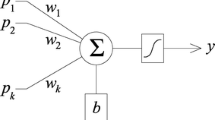Abstract
Neural networks are being used to construct meta-models in numerical simulation of structures. In addition to network structures and training algorithms, training samples also greatly affect the accuracy of neural network models. In this paper, some existing main sampling techniques are evaluated, including techniques based on experimental design theory, random selection, and rotating sampling. First, advantages and disadvantages of each technique are reviewed. Then, seven techniques are used to generate samples for training radial neural networks models for two benchmarks: an antenna model and an aircraft model. Results show that the uniform design, in which the number of samples and mean square error network models are considered, is the best sampling technique for neural network based meta-model building.
Similar content being viewed by others
References
Balmes E and GARTEUR Group on Ground Vibration Testing (1997), “Results from the Test of a Single Structure by 12 Laboratories in Europe,”Proc. of 15th IMAC, pp. 1346–1352.
Balmes E (2002),Structural Dynamics Toolbox User’s Guide 5.0.
Bucher CG A (1990), “Fast Efficient Response Surface Approach for Structural Reliability Problems,”Structural Safety,7: 57–66.
Chen S, Cowan CFN and Grant PM (1991), “Orthogonal Least Squares Learning Algorithm for Radial Basis Function Networks,”IEEE Transactions on Neural Network,2(2): 302–309.
Fang Kaitai and Ma Changxing (2001),Orthogonal and Uniform Experimental Design, Science Press, (in Chinese)
Levin R J and Lieven NAJ (1998), “Dynamic Finite Element Model Updating Using Neural Networks,”Journal of Sound and Vibration,210(5): 593–607.
Liu Yannian, Feng Chunbo and Qiao Xin (1994), “Study on Approximation Ability of Multilayer Feed Forward BP Networks,”Transactions of Nanjing University of Aeronautics and Astronautics,26:191–195. (in Chinese)
Lu Jingui (1995), “Research on Structural Analysis Using Neural Network,”Science in China,6:653–658. (in Chinese)
Madsen JI, Shyy W and Haftka RT (2000), “Response Surface Techniques for Diffuser Shape Optimization,”AIM Journal,38(9): 1512–1518.
Montgomery DC (2003),Design and analysis of experiments, New York: Wiley.
Ren Luquan (2003),Experimental Design and Analysis, Press of Advanced Education, (in Chinese)
Wang Jianzhong, Liu Chaobin and Zeng Fang (2001), “The Natural Frequencies Modification of Mechanical Structure Using Neural Network,”Journal of Wuhan University of Technology,23(5): 20–23. (in Chinese)
Wang Xiaofeng, Xi Guang and Wang Shangjin (2003), “Application of Response Surface Methodology in the Optimization Design Vaned Diffuser,”Journal of Engineering Thermophysics,24(3): 391–394. (in Chinese)
Wang Yunfei, Zhang Jianguo (2003), “Reliability Analysis and Calculation of the Missile and Actapter’s Separation Action,”Acta Aeronautica et Astronautica Sinica,24(4): 296–300. (in Chinese)
Wu Jianguo, Mao Haijun and Sun Qinghong (2003), “Analysis on Dynamic Mold of Spindle of Internal Grinder Based on BP Neural Network,”Journal of Nanjing University of Aeronautics and Astronautics,35(1): 105–108. (in Chinese)
Wu Yage and Wu Jianguo (2001), “Application of Response Surface Method Based on Neural Networks to Structural Reliability Analysis,”Journal of East China Shipbuilding Institute,15(6): 7–11. (in Chinese)
Zhang Lingmi (2002), “Computational Simulation and Model Validation with Application to Strength and Environment Engineering,”Structure & Environment Engineering,29(2): 42–47. (in Chinese)
Zhou Xiantong, Wang Bosheng and Ni Yiqing (2001), “Structural Parameter Identification Using Neural Network and Optimization Method,”Chinese Journal of Computational Mechanics,18(2): 235–238. (in Chinese)
Zhu Xuejun, Xue Liang and Wang Anling (2000), “Multi-objective Optimization of Complex Structure Using Neural Networks,”Mechanical Science and Technology,19(3): 368–370. (in Chinese)
Author information
Authors and Affiliations
Corresponding author
Additional information
Supported by: Specialized Research Fund for the Doctoral Program of Higher Education, China (No. 20010227012)
Rights and permissions
About this article
Cite this article
Qingguo, F., Lingmi, Z. Application of experimental design techniques to structural simulation meta-model building using neural network. Earthq. Eng. Eng. Vib. 3, 293–298 (2004). https://doi.org/10.1007/BF02858243
Received:
Accepted:
Issue Date:
DOI: https://doi.org/10.1007/BF02858243




